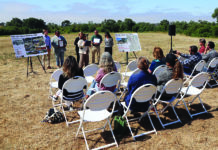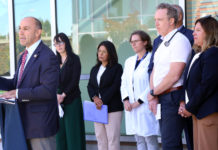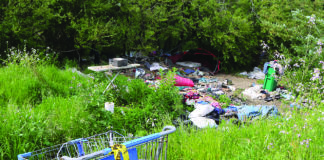
WATSONVILLE—Francisco Elcanto schleps a five-gallon bucket into the back seat of his car. A peek under the lid reveals an assortment of neatly packed cleaning supplies. Today, all he needs is some cleaning supplies, which he is borrowing from the Santa Cruz Volunteer Center.
The center is one of 20-plus organizations with booths at Ramsay Park in Watsonville, one of two relief centers that FEMA set up to help residents recovering from recent storms. Elcanto is one of the 900 people who have visited the Ramsay Park center in search of assistance since it opened. He plans on using the supplies he borrowed to clean up the mud and debris recent floods brought into his Santa Cruz home.
As a local landscaper, Elcanto has a trailer full of rakes and shovels—cleaning up debris is part of his job, so he is more familiar than the average homeowner with navigating the post-storm damages to his home.
Elcanto says when it comes to those damages, he’s lucky compared to some residents in Watsonville and Santa Cruz: his home was only flooded through the entryway, and he isn’t worried about any long-term damage to his house. That means he’s also not too concerned about the health risks of flood damage, aside from mold.
But as more residents return home, the health threats they face can be severe. Currently, the county uses an online portal to list resources, recommendations and updates for residents to access to help them return home safely.
Since the storms began, the county has completed more than 1,000 free inspections that can help with obvious structural and electrical threats and warn homeowners of future issues that can seriously impact long-term health. But with the high demand for inspections, it could take anywhere from three to seven days to get someone on site.
Over 180 homes are marked as yellow throughout the county, meaning they can be safely inhabited but require repairs. Twenty homes have been “red tagged,” which means they cannot be entered without significant repairs. Most red-tagged houses are in the Santa Cruz Mountains and are off-limits due to the movement of soaked soil that makes foundations unstable.
With unique issues plaguing different communities around the county, it’s challenging to implement a widespread alert system to notify residents of the health risks to consider before re-entering their homes.
“At the county, there’s no one-message-fits-all,” says Tony Nuñez, communications manager at Community Bridges.
Different communities will face unique threats and may need explanations in different languages and levels of detail, he explains.
Since the first storm on New Year’s Eve, Community Bridges has been going door to door in Watsonville and Felton communities, as well as sending text messages with services available to prepare for and respond to storm damage, including short- and long-term health threats. More than 350 people have filled out their winter storm assessments, allowing them to be connected with the best local resources.
“Our messaging is crafted around communities, so we can cater to different demographics,” Nuñez says.
Health risks: A case study
Amy Thomas’ home along Corralitos Creek flooded after the first atmospheric storm on New Year’s Eve and again in the subsequent waves of storms.
Residents like Thomas received text alerts telling them when it was safe to return home to evacuation zones, but there isn’t a notification system that tells people about the myriad safety and health threats that may lie inside their homes when they get there.
According to FEMA’s guide, “Coming home after a flood,” residents risk electrocution if precautions aren’t taken to examine electrical appliances. The minerals dissolved in water make it great at carrying electricity from appliances, wiring and outlets. Touching or stepping into this energized water can deliver deadly shocks, and electrical appliances that have been submerged can potentially cause fires if turned back on.
Appliances that run on natural gas can also be easily corroded, leaking highly flammable gas into the air that can cause poisoning, fires and explosions. If a home wasn’t dry within 48 hours of flooding, residents should also assume there’s mold growth. Mold can have devastating health impacts, with exposure leading to asthma attacks, eye and skin irritation and allergic reactions.
Thomas is one of the unlucky residents dealing with mold.
“They’re taking out everything,” she says. “They’re taking out the floors; they’re taking out the walls; taking out underneath the house—they’re taking it all out.” Even her insulation and electricity have to be removed.
Hiring a mold inspection or remediation professional can cost between $300 and $4,500. Thomas spent $6,900 on clean-up from the first storm alone, only to have her home flooded again.
Thomas also found fecal matter in her yard after the floods receded, which county officials attributed to local homeless encampments. The infected mud that swept across her yard and into her home means that the top layer of soil in her yard will also have to be removed.
One of the other major concerns with Thomas’ home is asbestos exposure. In houses built before the 1970s, it’s common to find asbestos in insulation, but it can also be a component in many other areas like tile floor and ceiling tiles, wall panels and caulking. Flooding can break down the bonds in these materials, releasing asbestos into the air. Asbestos fibers can also sit on the surface of standing water. If inhaled, they can cause long-term lung damage and lead to conditions like mesothelioma and lung cancer.
These precautions can help protect against other hazardous agents during flood clean-up, including any remnants of sewage, pesticides or other chemicals and bacteria that can collect in stormwater. Contaminants and bacteria in floodwaters can increase the risk of illness, such as rashes, fever, chills, ear infections, vomiting and diarrhea.
“We want to urge anyone, if you have any concerns or qualms that your home might not be safe, to get help,” Nuñez says.
Disaster Recovery Centers:
• Ramsay Park, 1301 Main St., Watsonville
• Felton Library, 6121 Gushee St., Felton
Community Bridges’ Free Cleanup Tools:
• La Manzana Community Resources, 521 Main St., Ste. Y, Watsonville, 724.2997
• Live Oak Community Resources, 1740 17th Ave., Santa Cruz, 476.7284
• Mountain Community Resources, 6134 Highway 9, Felton, 335.6600
• Santa Cruz Volunteer Center: 844.965.1386 or scvolunteernow.org/flood
• Water Quality Program: 454.4624 or wa**********@*************ty.us













From what I read above if homes are contaminated with toxic chemicals such as asbestos and human fecal matter and soil must be removed would that also apply to the thousands of acres of farmland? Will the farm workers be safe in the fields? Will the strawberry and lettuce harvest be exposed to E. coli from the focal matter that was eased into the fields? This flood could have devastating effects on farming as well. Will any soil testing be done on farmland?
Do we face another E Coli outbreak nationwide?
There have been a couple of articles addressing the contaminated farm lands. It is a major concern. Lands and soil are being tested. Yes it will have an impact on farming (floods). On the e-coli potential, yes that is a potential.
this will take time, effort and money to remove the toxic waste hazards that the flood brought us. it is clear that using toxic chemicals , like Roundup, are bad for both human and pet consumption.
Organic farming is truly the safest route for raising crops. the number of organic farmers is growing.
this is also why the sooner the Pajaro Flood Control project is completed, the better.
I agree with Steve on this point. Our area farmers cannot afford scraping the soil in their fields but nevertheless, the soil must be clean of E-Coli and other contaminants before the next crop
If there is another lettuce E-Coli outbreak nationwide from central coast farms it will completely ed estate the regions ag industry
I agree with Steve on this point. Our area farmers cannot afford scraping the soil in their fields but nevertheless, the soil must be clean of E-Coli and other contaminants before the next crop
If there is another lettuce E-Coli outbreak nationwide from central coast farms it will completely devastate the regions ag industry
wow! and you did not personally attack me. thank you.